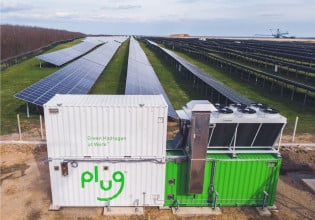Comparing Marine Energy-Powered Carbon Removal Methods
National Renewable Energy Laboratory examined the pros and cons of the most promising marine energy-powered carbon management techniques.
Can the ocean’s vast energy potential support gigaton-scale carbon dioxide (CO2) removal operations for the next 100 years? It’s a question National Renewable Energy Laboratory (NREL) researchers aimed to address in a lengthy study evaluating the most promising marine CO2 removal (mCDR), carbon capture (mCC), and carbon sequestration (mCS) methods.
The ocean acts as a giant carbon sink, absorbing nearly one-third of CO2 emissions released into the atmosphere. When absorbed, the seawater undergoes chemical acidification. Several ways are employed to deal with this excess carbon influx, including injecting carbon into rocks, capturing it through electrochemical techniques, or farming seaweed. Scientists are working to test and implement several piecemeal solutions.
A direct ocean capture system using membrane and electrodialysis technology pulls CO2 directly from the seawater for reuse or permanent storage. Image used courtesy of Captura Corporation
However, carbon management technologies are incredibly energy-intensive. Removing carbon from the ocean and atmosphere would require the U.S. to double its energy generation capacity. As long as fossil fuels supply the energy, the impact of carbon removal is null. Fossil fuels account for 60.4% of U.S. utility-scale electricity generation, and renewables—mainly wind and hydropower—only generate 21.3% of the nation’s electricity.
Still, mCDR powered by offshore wind and marine energy could assist the international target of limiting warming to 1.5°C (from pre-industrial levels) by 2100. According to NREL’s researchers, U.S. waters hold enough energy to cover the removal of 10 billion tons of CO2 annually.
Marine carbon capture, sequestration, and removal methods. Image used courtesy of NREL (Page 8)
What Are the Energy Requirements of Marine Carbon Dioxide Removal?
Marine carbon management technologies guzzle significant amounts of energy. In evaluating different options, the NREL researchers set thresholds to sequester a minimum of 1 gigaton (Gt) of CO2 annually on a 1,000-year timescale.
A full-scale assessment of mCC (top) and mCS (bottom) methods based on energy needs and capture and sequestration potential. Image used courtesy of NREL (Figures 8 and 9, Pages 26-27)
mCC methods are the most demanding, with up to 2,450 kWh per ton (/t) of CO2. This is close to the upper energy estimate required for onshore direct air capture, making it a valid comparison in the study.
mCS needs up to 480 kWh/t. This matches the upper quartile in onshore basalt sequestration, a more developed CS strategy.
mCDR, which entails both carbon capture and sequestration, was calculated as the sum of both mCC and mCS thresholds: 2,930 kWh/t.
An assessment of mCDR methods based on full-scale carbon removal potential and energy needs. Image used courtesy of NREL (Figure 7, Page 25)
Electrochemical Carbon Removal
The study identified electrochemical mCDR (or eChem) and deep-sea mCS as the most promising methods. That contrasts with biological techniques like microalgae farming, seaweed farming and sinking, and artificial upwelling, which need substantial energy to reach gigaton scales or fall short of the 1 Gt CO2 annual target.
Electrochemical mCDR and mCC leverage electrochemistry and seawater to separate pure CO2 from the ocean for storage or reuse or to sequester CO2 by producing alkaline inorganic carbon, such as carbonate. These methods generally use electrodialysis, which produces acidic and basic solutions from seawater, or electrolysis, a water-splitting process creating acid and base.
An example of an electrodialysis-based, renewable energy-powered ocean direct CC system. Image used courtesy of Captura Corporation
Base addition, carbonate formation, and basalt and seabed sequestration meet all three thresholds for energy requirements, scale, and storage longevity.
- Base addition (mCDR): This method increases ocean alkalinity, preventing the stored CO2 from re-entering the atmosphere. A diluted alkaline solution is placed directly into the water, which creates bicarbonate ions offering up to 100,000 years of CO2 storage. The unused acidic solution can be neutralized by pumping it into rock formations or the deep ocean, where the sea floor’s carbonate deposits can be dissolved to form bicarbonate ions and mitigate pH changes. (The study added a caveat about unclear environmental impacts, emphasizing the need for more field testing.)
- Carbonate formation (mCDR) adds enough concentrated basic solution in an enclosed space to produce mineral carbonates from the dissolved CO2. These carbonates can store CO2 for up to 100 million years.
- Basalt sequestration (mCS): CO2 is compressed and injected into basalt formations deep in the ocean. These reservoirs convert CO2 into stable carbonate minerals for permanent storage.
- Seabed sequestration (mCS) injects CO2 into self-sealing sediments with minimal biological activity. This method can hold greenhouse gasses for over 100,000 years.
- Acid-stripping (mCC): Among the mCC techniques studied, acid-stripping was the only one satisfying the energy and full-scale capture potential requirements. This method moves seawater into an acidification chamber to collect pure CO2. The dissolved CO2 then bubbles out like a soda drink. The gas is then vacuumed into a storage container, and the acidified seawater is mixed with a basic solution to return to a neutral pH before being re-released into the ocean. The extracted CO2 can be sequestered by combining deep-sea CS methods, such as basalt sequestration, to meet all three mCDR thresholds.
Role of Marine and Offshore Wind Power
eChem methods could remove 1 to 10 Gt of CO2 annually when powered by marine and offshore wind energy combined.
The study found that wave energy is ideal for mCDR methods, while ocean thermal energy conversion (OTEC) works better for deep-seabed CS.
Achievable scales of mCDR, mCC, and mCS using marine energy sources in U.S. locations, followed by offshore wind. Image used courtesy of NREL (Figure 10, Page 29)
While the study mainly focused on marine energy, there’s also a significant opportunity to use offshore wind for powering mCDR. To measure this potential, the NREL researchers included estimates from floating turbines and fixed-bottom installations.












